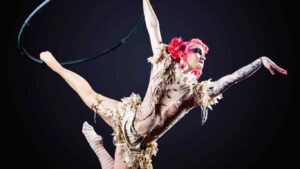Shoulder Instability in Aerial Sports
 In aerial sports such as pole, lyra, silk and aerial gymnastics, having good shoulder mobility (ie lots of flexibility) is an asset for athletic performance- in fact, its a pre-requisite for the elite or professional performers.
In aerial sports such as pole, lyra, silk and aerial gymnastics, having good shoulder mobility (ie lots of flexibility) is an asset for athletic performance- in fact, its a pre-requisite for the elite or professional performers.
Good shoulder mobility certainly allows athletes to access a greater range of skills and often enhances the aesthetic of tricks. However, in some circumstances, “the more” is not always “the merrier”. Are you someone or do you know someone who experiences shoulder pain and fatigue, that may settle from rest but comes back as soon as you/they return to aerial sports?
WHAT IS MULTIDIRECTIONAL SHOULDER INSTABILITY?
The shoulder is the most mobile joint in the body and it is normal that the ball of the shoulder glides and slides a little within the socket as we move our arm up or out. There are bony structures and various soft tissues (ligaments, tendons and muscles) that all play an important part in working collaboratively to produce shoulder movement, while maintaining the ball of the shoulder within the socket through extremes of range of motion. Shoulder instability describes abnormal looseness of the shoulder joint that causes pain, such that the humeral head (ball of shoulder) slides beyond the parameters of the glenoid fossa (shoulder socket). There are subtypes of shoulder instability including traumatic e.g. dislocation from fall and atraumatic (not from an onset of injury) e.g. repetitive pole iguana. In this article, we are discussing specifically atraumatic multidirectional shoulder instability (MDI) in aerial sports.
Multidirectional instability (MDI) of the shoulder is generalized laxity in several directions that causes pain. Some individuals have naturally loose ligaments that predispose them to instability. Others that perform repetitive shoulder movements in sports (e.g. aerial straddle inverts) that stretch and cumulatively create repetitive microtrauma can lead to acquired capsular laxity and possible instability. These are the main causes that predispose athletes to MDI.
Individuals with MDI often complain of a feeling of instability e.g. as though the ball of the shoulder joint is slipping out of its position, and that they need to modify or avoid their specific activities. Pain varies greatly in location and intensity and is commonly felt in the shoulder during overhead exercise.They may also experience tingling, numbness and popping sensations. In addition, they often report increased shoulder muscular fatigue during repetitive activities which impacts their performance.
WHAT CAN YOU DO?
MDI presentation varies depending on an individual’s past injury history, tissue quality and laxity, sporting requirement and schedule and training history.Consequently, , management can look very different from one person to another, and it is advised that athletes have their shoulder assessed by a physiotherapist who understands their sport well.
Conservative management is the first port of call for individuals with MDI. In general, this involves:
1) A tailored strength and conditioning program that consists of exercises that target the rotator cuff muscles (which help stabilise the ball within the socket), the scapulothoracic muscle group (which are involved in movement of shoulder girdle), and dynamic stability & control exercises that are specific to your aerial sports e.g. handstand shoulder tap.
2) Training modifications which may involve your Physiotherapist working with your coach/ instructor on identifying technical errors that are causing overload on specific structures in the shoulder joint, and temporary substitution of skills that are provocative to allow stability and control to be built first.
Has your shoulder been an area that deters you from progressing in aerial sport due to recurring pain whether it is from hanging, inverting, or flipping? Have you been told that it is just weakness causing your pain but strength exercises alone have not helped you all the way through with your ongoing shoulder pain and discomfort? Speak to one of our physiotherapists to get to the bottom of your shoulder pain so you can keep training, progressing and enjoying your aerial sport.

































